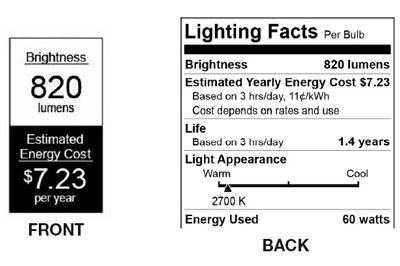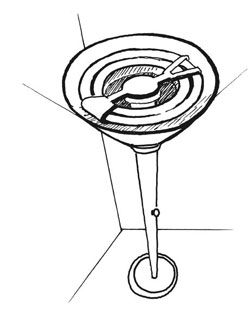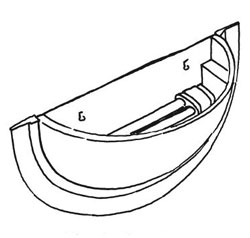The emergence of higher-efficiency lighting technologies has led to greater choice and significant energy savings. At the same time, what used to be a simple routine purchase has become much more complex. That doesn’t mean it has to be difficult, and looking on the bright side, most of these new light bulbs will last much longer than traditional incandescents, so you won’t find them on your shopping list nearly as often. In this section, we’ll address each of the major considerations involved in selecting the right bulb for each of your main light fixtures.
When shopping for new bulbs, be sure to look to the Lighting Facts label required on most common screw-based lamps. The ENERGY STAR label will help identify high-quality energy-efficient LED lamps. To qualify, lamps must comply with specifications on energy use, light output, lamp life, and other operating characteristics. Look for ENERGY STAR to ensure you are getting lamps that have been tested and certified to meet a wide range of performance requirements. A full list of ENERGY STAR lamps is available at energystar.gov.

Light Output
The familiar wattages we’ve all used to select light bulbs since we were kids are becoming obsolete with the phase-out of traditional incandescent bulbs and wider adoption of lamps that use very different amounts of power to provide similar levels of light. While most manufacturers label their halogen incandescent, CFL, and LED lamps with the equivalent incandescent wattage— 40W, 60W, 75W, and 100W, it is useful to know how the different wattages translate in terms of light output (or lumens). Moving forward, lumens will replace wattage as the key characteristic for identifying the right light bulbs. This makes a lot of sense; after all, when you purchase a light bulb you’re looking to get a specific amount of light, not a prescribed power consumption. The table below will help you match incandescent lamps with alternative technologies to get the same light level.
Equivalent Lamp Wattages
| Traditional Incandescent | Typical Light Output | Halogen Incandescent | Compact Fluorescent | LED |
|---|---|---|---|---|
| WATTS | LUMENS | WATTS | WATTS | WATTS |
| 40 | 450 | 29 | 9-13 | 6-8 |
| 60 | 800 | 43 | 13–15 | 9-11 |
| 75 | 1,100 | 53 | 18–25 | 13-15 |
| 100 | 1,600 | 72 | 23–30 | 18-20 |
| 150 | 2,600 | 30–52 |
Efficacy
Light bulb efficiency, referred to as efficacy, is stated in terms of light output in lumens per watt of energy consumed. While traditional incandescent lamps provide about 15 lumens per watt (lpw), halogen incandescents achieve about 20 lpw. CFLs represent a leap in efficacy, offering 55 to 65 lpw. As of 2017, LEDs are able to maintain 78-130 lpw depending on the product and application, and further efficacy improvements are expected.
Color Temperature
The shade of white light emitted by a lamp is called correlated color temperature — look for the value reported in Kelvin (K) on the lamp packaging. Lower Kelvin values (in the range of 2700K to 3000K) correspond to a warmer light comparable to a conventional incandescent that enhances yellow and red tones. Lamps with higher values (typically 3500K, 4100K, 5000K, and 6500K) give off a cooler white light that enhances blues and greens. These bulbs are often referred to as natural, bright white, or daylight lamps. The following table explains some terms you may encounter on lamp packaging. Try a few out with your family and see which you prefer. For instance, you may like a “soft white” for your living room and “cool white” for your bathroom.If the store where you are searching does not have a wide enough selection, suggest that they provide more offerings and try somewhere else. Tunable LED fixtures allow the user to adjust color temperature across a wide range so you can adjust the color temperature for different moods or times of day much like using a dimmer switch to control light output. Desk and floor lamps as well as overhead fixtures with this capability are becoming more widely available.
Other Considerations
Lamp Lifetime. Expected lifetime can be an important consideration when selecting bulbs for hard-to-reach fixtures as well as those that are used infrequently. LEDs have long expected lifetimes: 10,000 to 25,000 hours. These long-lived lamps will really pay off in the most used fixtures as well as those in high ceilings or other inconvenient locations. Halogen incandescents typically operate for 1,000 hours; extended-life versions can last for 3,000 hours. Select longer-lived LEDs for your most-used fixtures. Less expensive LEDs with shorter lifetimes (around 10,000 hours) are a good choice for closets or other spaces where lights are rarely on for more than a few minutes.
Dimming. Virtually all incandescent bulbs and the majority of LED lamps are dimmable. With LEDs, be sure to get a dimmer switch that is compatible with the lamp you’ve selected.
Durability. LEDs are a great option for flashlights, headlamps, and outdoor walkway lamps. They not only use very little power and last longer, they are also shatterproof and shock resistant, and their performance is not degraded by low temperatures or moisture.
Decorative Lighting. During the holidays, most utilities experience a significant surge of electricity usage from the lighting of Christmas trees, yards, and other ornamentation. That means more pollution in the air and more of your money to the utility. LED string lights are now widely available in many shapes and sizes and in white or a range of colors including multi-color and color-changing sets, providing a more durable and low-energy alternative. They may cost more up front, but one utility in California estimates that using LED lamps will cost you just $0.45 over the course of a holiday season, compared to $5.00 for mini incandescent string lights and $75 for large incandescent string lights!
Environmental Benefits. A single 10-watt LED, used in place of a 43-watt halogen incandescent light bulb, will save about 800 kWh over its lifetime. That single replacement will eliminate emissions of 1000 pounds of carbon dioxide, 4-6 pounds of sulfur dioxide, and 8 mg of mercury on average. If your electricity is generated in a coal¬fired power plant — as is half of all electricity produced in the U.S., the emissions reductions will be almost double.
Dollar Savings Achieved by Switching to Energy-Efficient Lamps
| Replace 43-watt halogen incandescent with: | Savings after 1st year | Savings after 2nd year | Savings after 3rd year | Savings after 5th year | Savings after 10th year |
|---|---|---|---|---|---|
| 13watt CFL: | |||||
| Light on 2 hrs/day | $1.11 | $5.21 | $9.32 | $16.03 | $35.06 |
| Light on 4 hrs/day | $5.21 | $11.92 | $20.14 | $35.06 | $68.62 |
| Light on 8 hrs/day | $11.92 | $29.85 | $41.77 | $68.62 | $140.24 |
| Light on 12 hrs/day | $20.14 | $41.77 | $61.91 | $100.68 | $207.37 |
| 9-watt LED: | |||||
| Light on 2 hrs/day | $(0.55) | $3.91 | $8.36 | $15.77 | $36.54 |
| Light on 4 hrs/day | $3.91 | $11.31 | $20.22 | $36.54 | $76.57 |
| Light on 8 hrs/day | $11.31 | $27.63 | $43.94 | $76.57 | $158.14 |
| Light on 12 hrs/day | $20.22 | $43.94 | $69.19 | $115.11 | $238.21 |
Assumptions
| Halogen Incandescent | CFL | LED | |
|---|---|---|---|
| Lamp output (lumens) | 750 | 825 | 800 |
| Lamp life (hours) | 1000 | 10000 | 25000 |
| Lamp cost ($) | $1.50 | $3.00 | $5.00 |
| Electricity cost | 11.9 ¢/kWh | 11.9 ¢/kWh | 11.9 ¢/kWh |
Economics. Because high-efficiency light bulbs save electricity and last longer, they are a profitable investment. To figure out your return, you have to look at both the purchase and operating costs to arrive at total life-cycle costs. It may surprise you to learn that incandescent bulbs cost a lot more to operate than they cost to buy. When you spend a dollar for a 53-watt halogen incandescent light bulb (equivalent to a 75-watt traditional incandescent), for example, you’re committing yourself to spending close to $5.00 for electricity (at 11.9.¢/kWh) over that bulb’s expected 750-hour life. In regions with high electricity prices, you could spend up to twice as much.
With an LED, you might spend $5 to buy the lamp, but you’ll save money in the long run. For the same light output, the LED will use just over $1.00 in electricity, but the savings really start to add up as you’ll buy a lot fewer lamps over the LED’s 25,000 hour expected life. The longer a particular light fixture is used each day, the faster a high-efficiency replacement will pay for itself. See for yourself in the table above. Even with just one switch, you come out ahead in the first year for all but the least-used lamps. Just imagine how much money you would save if you switched all your bulbs to LEDs!
Ready to Buy? Check out the Enervee Marketplace
ACEEE’s partner, Enervee, makes it simple to find the best deals from your favorite retailers on the most energy efficient light bulbs that meet your needs.



